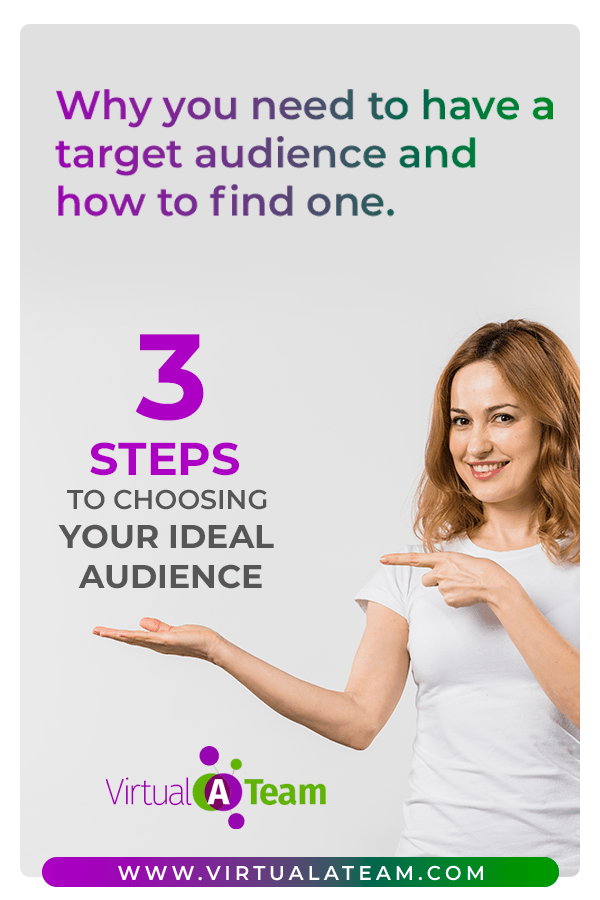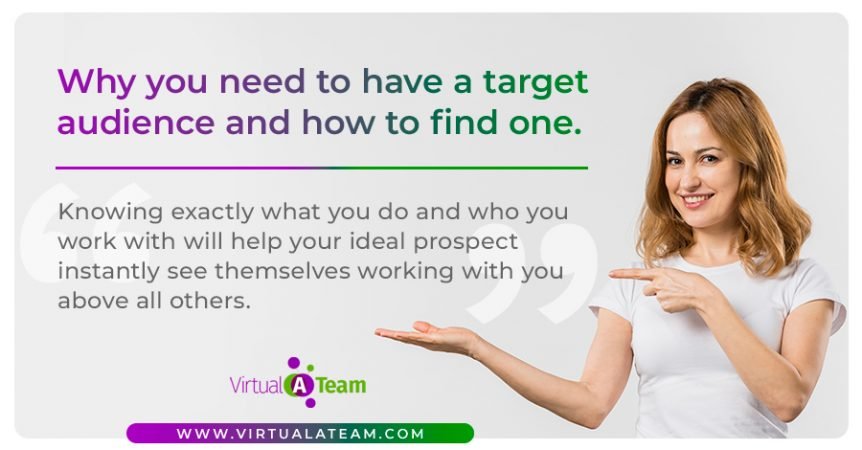I work with a lot of coaches and many of them struggle to identify their target audience. When I ask them, in our initial interview, who they work with it is often vague at best.
Let’s talk about dating apps. Bear with me, it’s totally relevant and I’ll get to the point.
Dating apps help daters find “the one” in an enormously large dating pool. If you’ve been dating recently (I have many friends on this journey right now), you know there are a LOT of stinkers and few good eggs in the pool. Dating apps help a user narrow their search to people who have the qualities they desire. And they cut anyone who doesn’t fit what they are searching for.
George is a handsome 24 year old…
Too young.
Michael is a world class traveler…
I hate to fly.
Stephen loves to cook, hike, and spend quiet evenings in front of a fire…
Oh, this guy has potential.
Prospects for your coaching business need something like a dating app to help them determine if your business is the right fit for them.
Susan is a coach who focuses on women in menopause who…
Not quite menopausal, yet...
Todd is a coach who works with men struggling in their relationships…
I’m a woman.
Margaret is a coach who helps solopreneurs create systems in their business and life…
Now, this might be a good fit.
And this is just the surface. Knowing exactly what you do and who you work with will help your ideal prospect instantly see themselves working with you above all others.
The Target Audience Myth
Some coaches are afraid that if they have a niche or target audience, they may lose out on working with other people. Let me just play Mythbusters for a moment.
My target audience, at a very high level, is working with coaches and speakers. That doesn’t mean I don’t work with financial advisors, professional organizers, or real estate professionals. It simply means my marketing is directed to those individuals who are my bread and butter clients.
It’s called IDEAL or TARGET for a reason. It means it isn’t the ONLY people you work with, just the ones you MOST want to work with. My marketing is all about women. I include tons of pictures of shoes and “girly” stuff and yet I have male clients as well.
Don’t assume that creating an ideal target audience is limiting who you can do business with.

Benefits of Finding Your Ideal Target Audience
So what are some of the benefits to having a target audience?
- Eliminate the prospects you just aren’t interested in working with. I don’t work with retail businesses and I don’t work with e-commerce related businesses. They just don’t make me happy. By knowing this, I can invest my time on finding “the one”.
- Save money on marketing. Marketing isn’t cheap these days. It’s harder and harder to get the same results that were once free. By honing in on who you want to target, you increase your results while decreasing your costs.
- Save time. It’s time-consuming to create content for “everyone”. And often “everyone” content is boring and just doesn’t speak to anyone so no one ends up listening. Creating content for your target audience takes the same amount of time but doesn’t land on deaf ears.
Pro Tip
MORE REFERRALS! A clearly defined audience helps people you know refer more business to you.
Do you remember the ads with Colin Kaepernick for Nike? Those ads were very polarizing. You either went out and bought a pair of Nike shoes or burned the ones you currently own. For Nike, they knew exactly who their target audience was and didn’t care if they offended a large section of the population. Nike was able to speak to their niche in a way that got many of them raising their hands and opening their wallets.
Sure, Nike lost some buyers but they more than made up for it in a boost to their sales.
This is where knowing who your target audience is can be very valuable.
How to Choose your Target Audience
There are a few steps you can take to help you narrow down and find your target audience.
Step 1 - It's About You
If you love what you do, you’ll never work a day in your life.
What do you love? Let’s be honest, if you can work with people that have something in common with you, you’ll both have a more pleasant and productive experience.
Make a list of everything you are interested in or passionate about.
Step 2 - Don't Sell Snake Oil
This is where a lot of coaches get hung up. They want to solve every problem for every person. It’s like listening to the old snake oil salesmen hawking their wares. It cures everything from arthritis to zygomycosis!

Think of it this way, when you have brain cancer, you want to go to a doctor who specializes in brain cancer, not a generalist who does a little of this and a little of that.
Focus in on the problems you really love to solve.
Pro Tip
If you have a personal challenge you’ve overcome and have a great story to tell, this can be an excellent target audience.
Once you have some ideas of problems you solve, do a little research. Use forums like Reddit and Quora to see how many people are asking about that problem. Look up books on the topic and see what’s out there. Use this information to fine-tune your specialty. You can also use it to discover how in demand a solution for this problem may be.
Step 3 - SHOW ME THE MONEY!
You may be absolutely in love with the idea of working with homeless women in need of life skills and there is definitely a demand for this. But, can your desired audience pay, and are they willing to?
Finding your niche target audience means identifying that sweet spot where there’s a need, a desire, and a willingness to pay for the solution. Missing one or more can make finding ideal clients that much harder.
One note: Competition for your target audience isn’t a bad thing. It means there is already money being made in your target niche. No competition? Odds are, you haven’t stumbled on a new idea, you’ve stumbled on an idea that is hard to monetize.
Is Your Multipassion Getting in Your Way?
Many coaches are multipassionate. They love to do a LOT of things and this makes it hard to land on a specific niche. When they start to think about this, it almost feels claustrophobic, like they are being boxed in.
Here’s the thing, you can work outside the box even when you have a small group you work with. It’s about changing the way you define your audience.
Focus more on interests than on demographics.
Is your audience artsy? Do they love to be outdoors? It may not matter if they are male or female, young or old, if they have something in common, laser in on that.
Where do they spend their time?
It could be a club, group, or parenting organization. They may choose to volunteer or go to professional networking meetings. Figure out where they hang out and that will help you know what they have in common.
What are they passionate about?
Sometimes taking a stand can be smart marketing, just like it was for Nike. Knowing what your audience is passionate about can help you filter out who they are. Animal rights? Anti-bullying?
Often this comes from your own passions. If you are at odds with the beliefs of your target audience, they will sense that.
Is there something special or unique about them?
I once had a client who preferred to work with autistic entrepreneurs. She had an autistic child who always wanted to start a business and found that to be her unique niche. She did well with it as there aren’t a lot of people on the “dating app” that are attracted to autistic entrepreneurs.
Think about the problems you solve, what about that problem ties this group together?
I have one client who is a communications coach. She works with professional women to help them find their voice in the workplace. Now, she could focus on entrepreneurial women or women in relationships and what she does applies to all of them but her messaging is geared towards her IDEAL target audience.

How to Create a Winning Buyer Persona
Now that you have identified your target niche, it’s time to create the buyer persona. Think of this as the “job description” for your ideal target audience. Who are they, where do they hang out, what do they like to do?
Creating a buyer persona can be an entertaining process. It’s like building a cartoon character for an animated film where your business is the star. Using an image to represent the persona helps support the description you create.
Let’s say that you own a career coaching business that helps millennials find the right career that matches their personalities and skills. You will have about 3 to 4 buyer personas that depict your intended audience. Three examples are given below.
Buyer Persona #1: Jane, the Late 20 Something Year Old Trying to Change Careers
 Name: Jane
Name: Jane
Age: 26
Average Salary: US$56,000 per annum
Location: Chicago, Illinois
Interests: Writing, reading, charity work
Description: Jane has been working in corporate America for the past 6 years and is tired of the monotony. She wants a career where she can use her writing skills to create meaningful impact. She is looking for advice about becoming a solopreneur and how to build a successful small business that will enable her to leave her 9 to 5.
Buyer Persona #2: Patrick, Early 30-Year-Old Looking for a New Position in the Same Industry

Name: Patrick
Age: 31
Average Salary: US$75,000
Location: Chicago, Illinois
Interests: Finance, investment banking, business development
Description: Patrick has been working as a financial analyst for the past 5 years. He enjoys working in the finance sector but wants to transition to an investment banking career. He is looking for advice about the best way to use his existing skills to find the right job in that area.
Buyer Persona #3: Lisa, 30-Year-Old with a New Postgraduate Degree

Name: Lisa
Age: 30
Average Salary: US$65,000 per annum
Location: Chicago, Illinois
Interests: Entrepreneurship, business development
Description: Lisa recently completed an MBA and wants to stand out as a great business management candidate. She wants help finding the right job, creating a strong resumé and excelling in the intense interviews she will face at this level.
What Can You Learn From These Buyer Personas?
- Be as specific as possible. You’ll be more equipped to reach your target audience if you’re very specific about who you’re trying to reach.
- Name your personas. It makes it easier to reference them when planning your campaigns.
- Images speak volumes. Notice that the images used in these buyer personas featured people of color. The needs of this target audience are quite different from those of a Caucasian audience. Do you want to create an avatar for your buyer persona? You can create one easily by clicking here.
- The buyer personas represent 3 different types of people with completely different needs. Yes, they all need career advice but the type of advice they need differs. You must create highly personalized campaigns that meet the needs of each persona. If you try to say the same message to all 3 individuals, none of them will feel like you are speaking to them and all 3 are likely to pass.
Need help creating your buyer persona? We love this handy tool from Hubspot. Make My Persona
The Proof is in the Dating
When you finally find your ideal target audience, it’s like finding “the one”. There’s less effort involved in attracting and keeping them around. The whole process just feels... GOOD, for both people.
Once you’ve identified your audience and crafted your buyer persona, you can use that information to focus your marketing so that you save time and money.
Want more help fine-tuning your ideal target audience? Join the Business Building for Coaches and Speakers group on Facebook and post your questions there.



